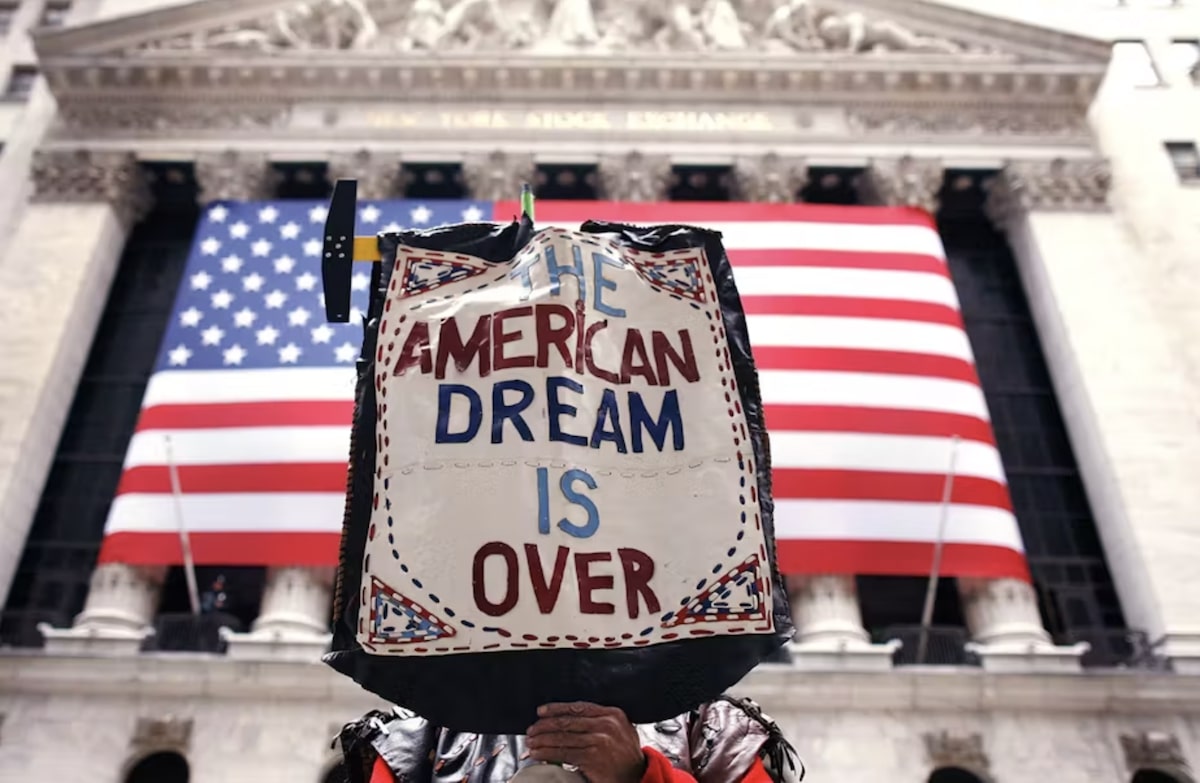When we were young, most believed we would achieve “the American Dream” someday. Today, two-thirds of us believe that the American Dream is unattainable. That is a searing indictment of a system coming apart at the seams right before our eyes. As a child, it seemed like just about everyone was part of the middle class. In those days, people took for granted that you could have a nice home, a beautiful family, a couple of vehicles, and a comfortable retirement. But now, that kind of middle-class lifestyle is out of reach for most of the country. In fact, a brand new Wall Street Journal/NORC poll discovered that only about one-third of the population thinks that the American Dream “is still alive”…
A Wall Street Journal/NORC poll published Wednesday found that only about a third of U.S. adults believe the American dream is still alive.
A survey of 2,501 people conducted by the Public Religion Research Institute twelve years ago found more than half of respondents believed the American dream “still holds true,” but now only a third feel that way, according to a recent WSJ/NORC poll of 1,502 adults. The study also found an increasingly large gap between people’s economic goals and what they think is actually attainable — a trend that was consistent across gender and party lines, but was especially common amongst younger generations.
Those numbers are yet more evidence that the middle class is dying.
Once upon a time, we had the largest and most prosperous middle class in the planet’s entire history.
But now, most of the country is struggling deeply.
So please don’t try to convince me that the U.S. economy is in good shape.
Our standard of living has been steadily going downhill for a long time, and things have been getting worse for almost everyone.
The same Wall Street Journal/NORC poll also found that only 10 percent of Americans believe that becoming a homeowner is “easy or somewhat easy”…
The decline in faith in the American Dream coincides with a decline in the share of Americans who believe homeownership and financial security are attainable, the poll shows. Only 10% of respondents to the WSJ poll believed becoming a homeowner is “easy or somewhat easy,” despite 89% of respondents viewing homeownership as “essential or important to their vision of the future.”
The same was true of financial security, with only 9% of respondents claiming achieving financial security is “easy or somewhat easy,” despite 96% believing financial security is “essential or important,” according to the WSJ.
These days, you can’t get about 90 percent of Americans to agree on just about anything.
But when it comes to this, there is an overwhelming consensus.
Everyone can see that housing has become incredibly unaffordable.
In fact, we just learned that home prices just set another brand new all-time record high…
Even as mortgage interest rates were rising, home prices reached the highest level ever on the S&P CoreLogic Case-Shiller U.S. National Home Price Index.
On a three-month running average ended in June, prices nationally were 5.4% higher than they were in June 2023, according to data released Tuesday.
Overall, U.S. home prices are up more than 1,000 percent since 1974.
Those who bought homes in the 1970s are in great shape today.
But I feel so sorry for those currently trying to buy homes.
A big part of the problem is that much of our housing inventory has become financialized.
Millions of homes are being purchased as investments, and this even includes large numbers of low-priced homes…
Real estate investors bought 26.1% of low-priced U.S. homes that sold in the fourth quarter. That’s the highest share on record and is up from 24% a year earlier.
Today, we have an absolutely massive housing crisis in this country.
This is one of the reasons why millions of people are now living in their vehicles.
Our middle class is being systematically eradicated, and we are just standing aside and letting it happen.
Today, vast numbers of Americans are living as paupers in the nation that their forefathers conquered.
Throughout our history, most young people could safely assume that they would do better than their parents did.
But that started to change several decades ago. According to a couple of very well-known economists, “only around half of children in 1980 ended up wealthier than their parents.”…
For many young people, the issue stems from feeling that they are worse off and face a tougher economic future than their parents dealt with at their age.
According to MIT economics professor Nathaniel Hendren and Harvard University economist Raj Chetty, only around half of children in 1980 ended up wealthier than their parents.
In 1940, this figure stood at around 90 percent – with the gradual decline only increasing since the 1980s.
Needless to say, those who are being born now are facing a very dismal future.
But this is what we voted for as a society.
We just kept sending the big spenders back to Washington. As a result, it now takes a boatload of money for the average family to live the American Dream…
The GoBankingRates analysis determined the American Dream now costs more than $150,000 a year for a family of four, but that figure differs widely depending on where you live.
If you live in Hawaii, it takes an annual income of $260,734 for a family of four to live the American Dream.
If you live in Mississippi, it takes an annual income of $109,516 for a family of four to live the American Dream.
Of course, making over $100,000 a year is out of reach for most of the country at this point.
Now, we have reached a stage where many people have simply given up, and the economic outlook for the future is not good at all.
Previous generations handed us the keys to the greatest economic machine that the world had ever seen, but we allowed our leaders to wreck it.
We have debased our currency, we are drowning in debt, and a big chunk of the population is no longer capable of supporting themselves.
We thought we could defy the laws of economics, but we were wrong.
So now we are headed into a period of severe economic pain, and that will certainly not be pleasant.
Cross-Posted with Conservative Firing Line






